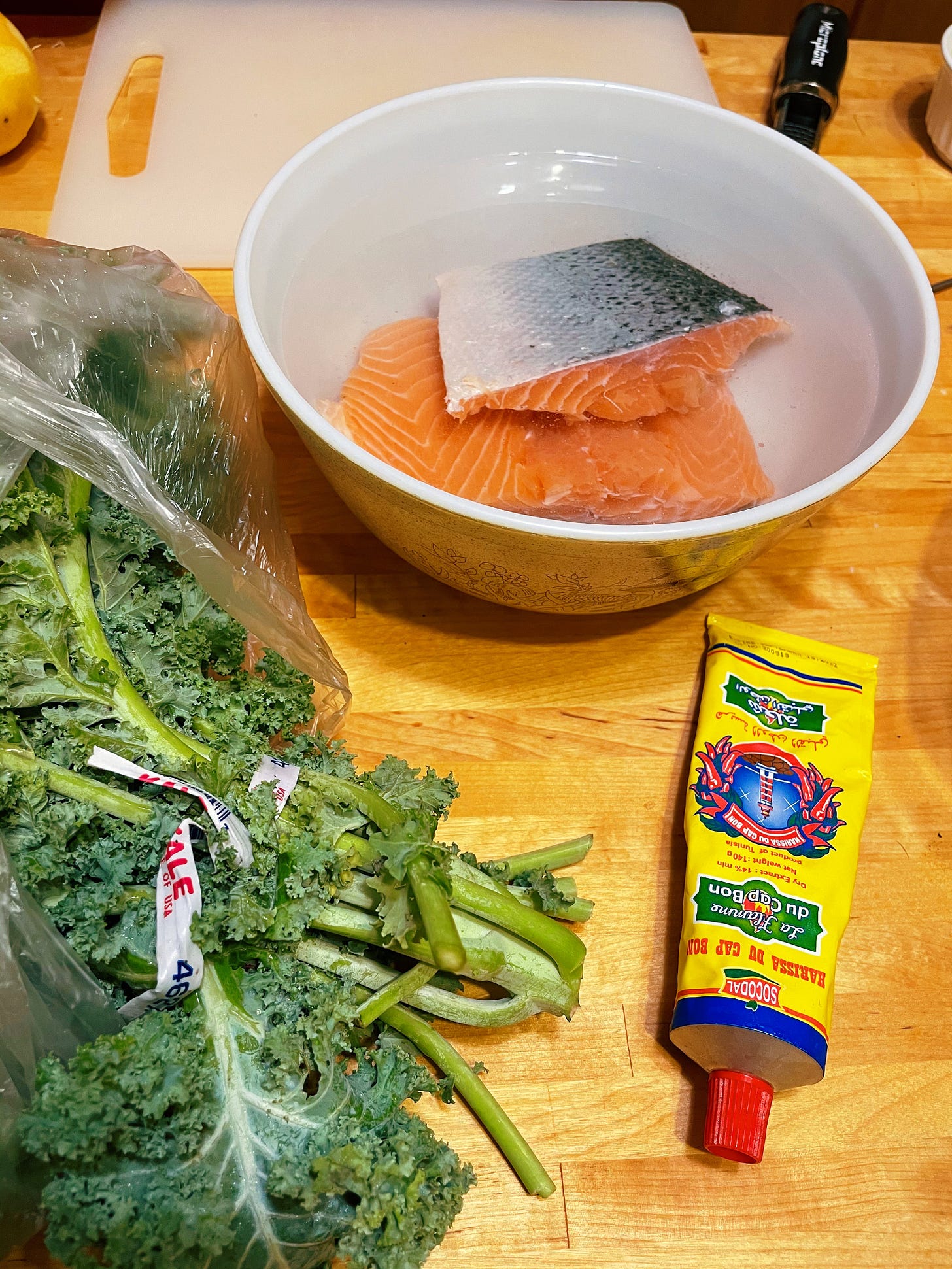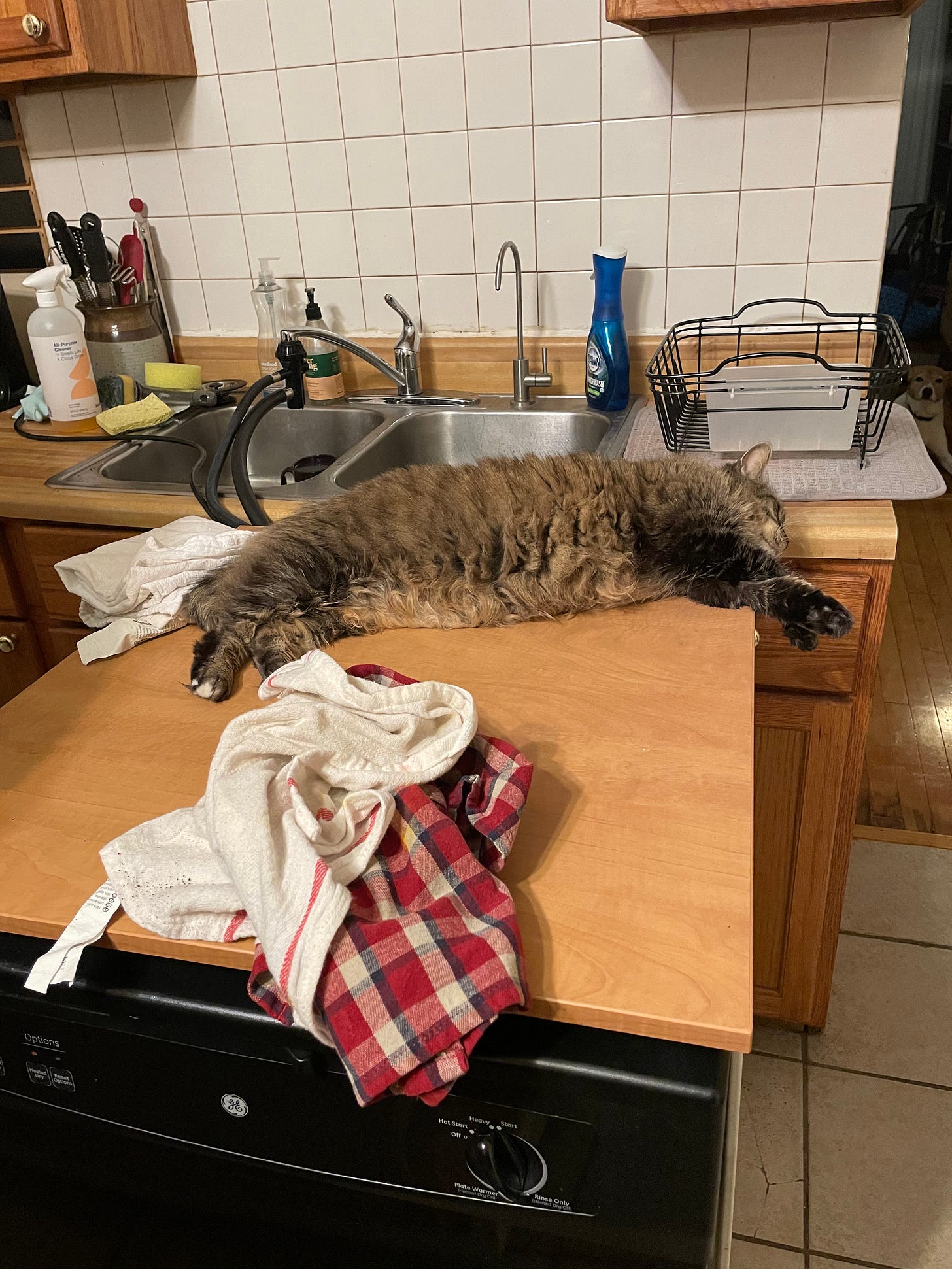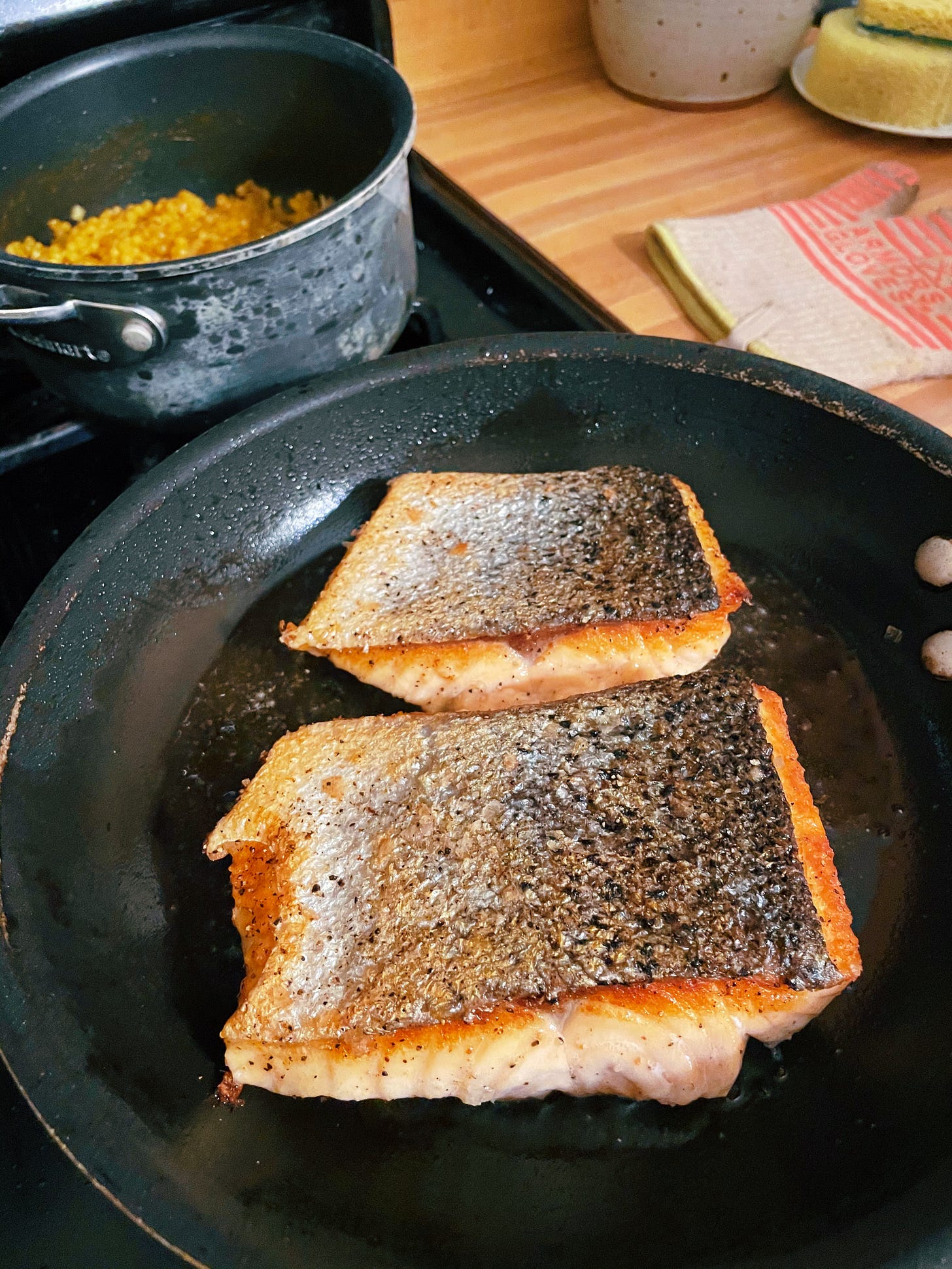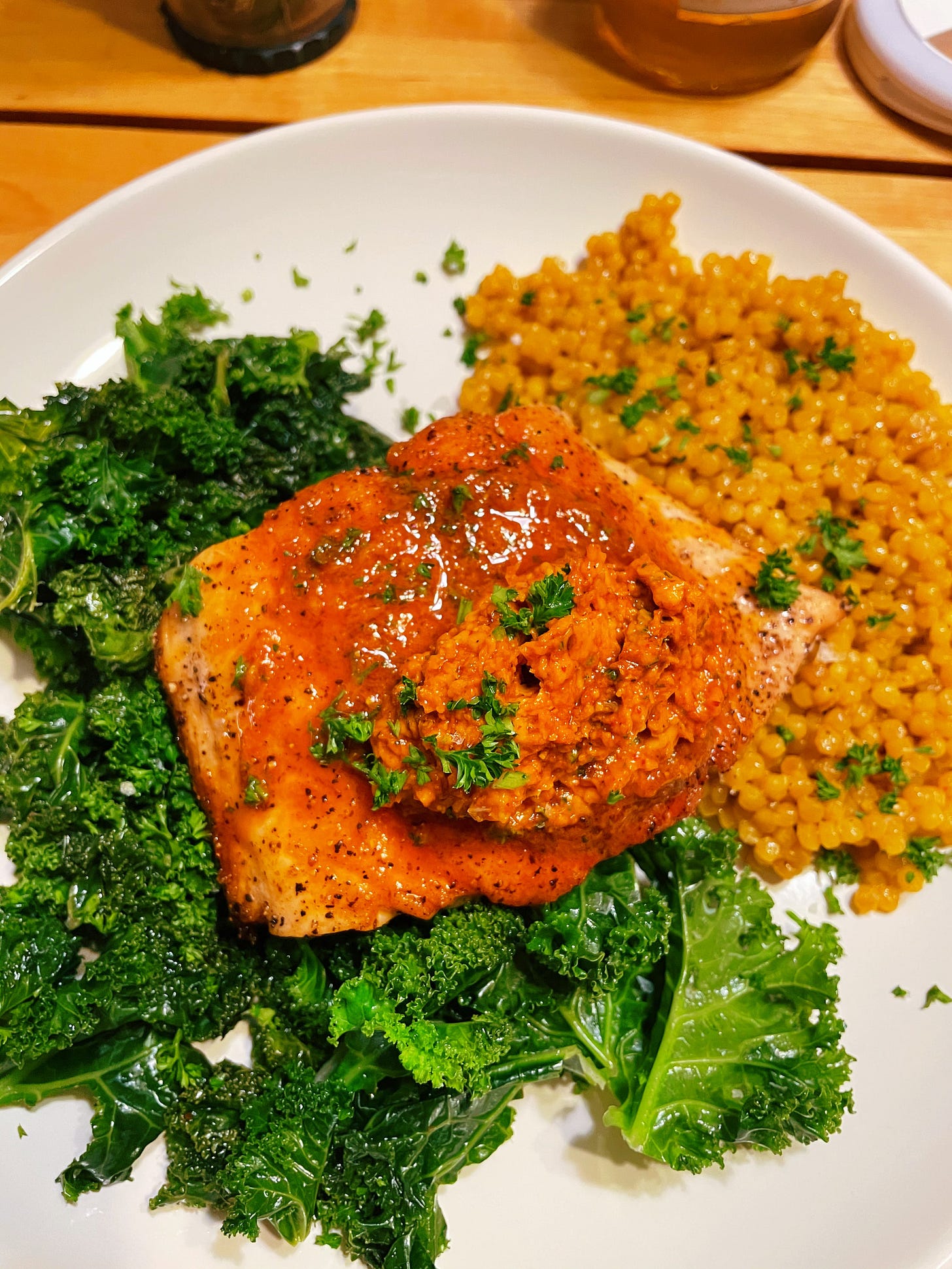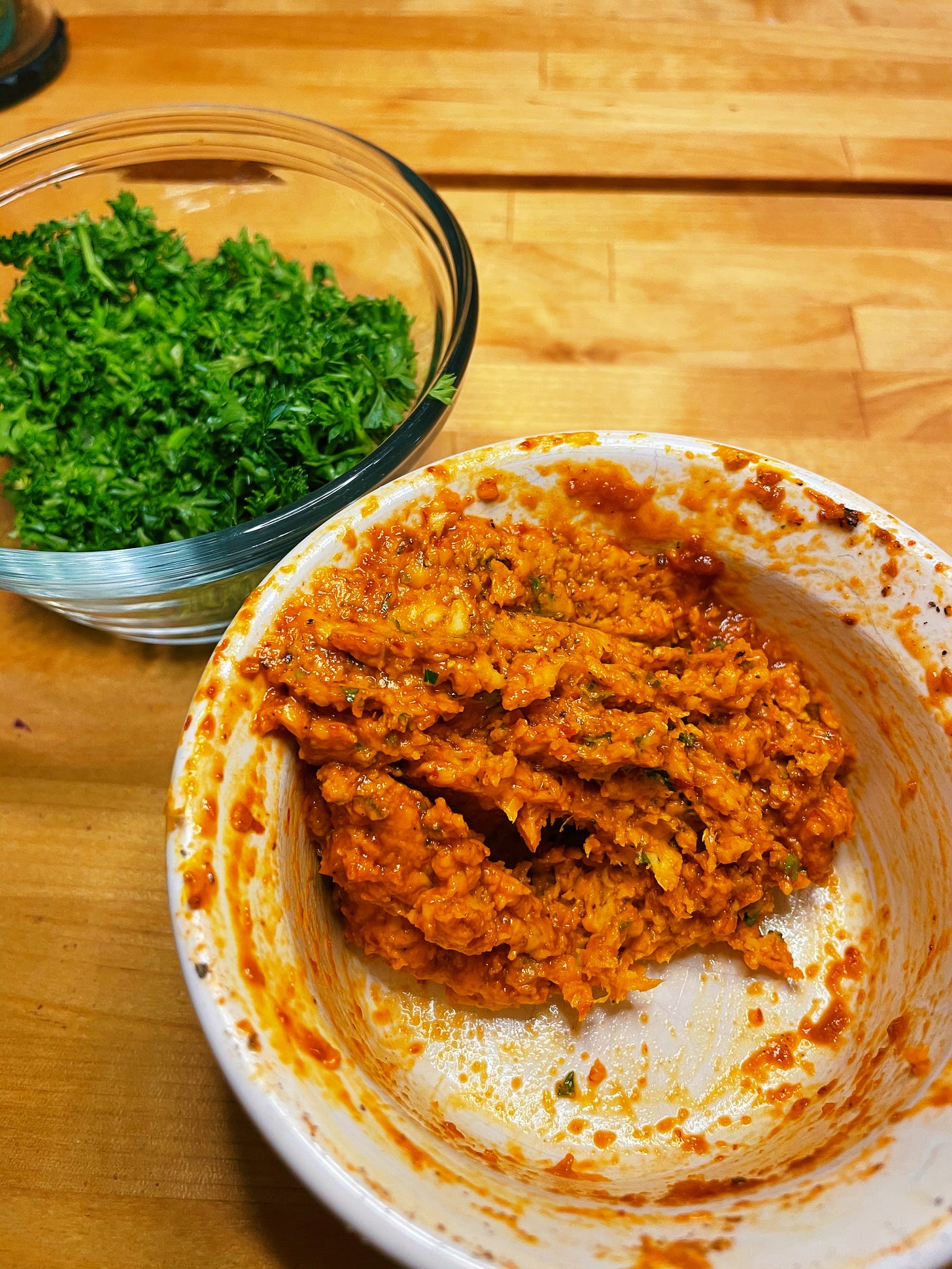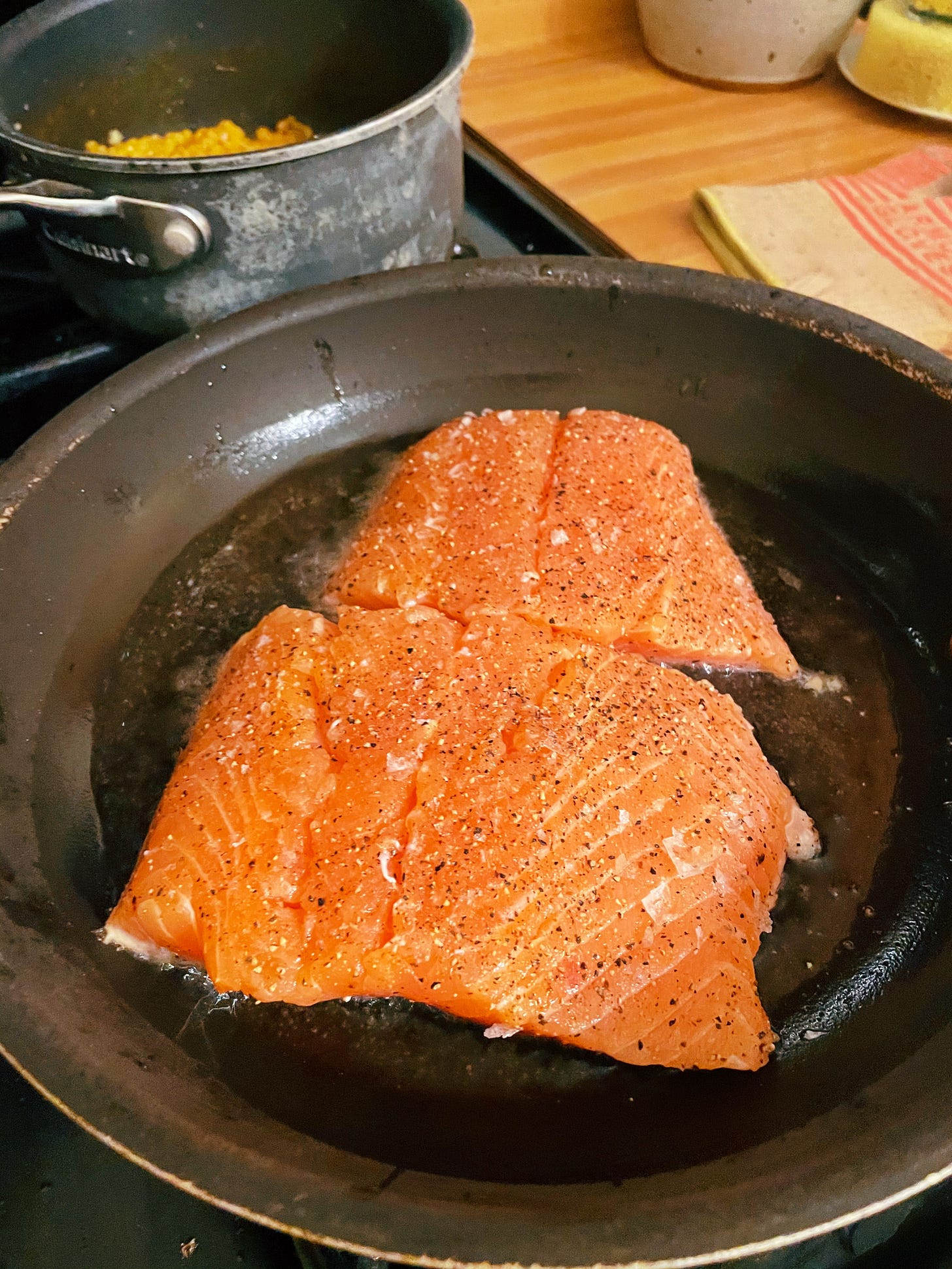vol. 4: crispy salmon, kale and couscous with harissa butter
labors of love and just plain labor
We got a dishwasher a few weeks ago and it is life-changing. Truly, I don’t think I would be more excited if you told me scientists invented a technology to make our pets immortal. My boss had one of those rolling ones sitting in her basement that she graciously gifted us, having purchased it years ago at her old house after one too many evenings spent hand washing dishes with her husband. We both have been working a lot lately, and staring down the dirty plates that made us so very happy just hours ago for dinner is a bridge too far most nights. It really is life-changing to get that time back - to sit and put our feet up as the machine gurgles and hums away in the other room.
Johnathan and I don’t fight often, but dishes are a source of tension, as they are in basically every household, alongside laundry and whatever else suddenly turns into mountains and is a pain in the ass. He is my beloved treasure, but he loves to do a mise en place in every conceivable ramekin we own, for example, and then the sink is suddenly overflowing and we’re both crabby about the work ahead.
There’s a concept in Marxist feminist theory for this kind of work (don’t worry, this won’t hurt) called reproductive labor, which is the unpaid work that keeps workers alive and generating labor value out in the world — cooking, cleaning, remembering the bills and so on. “Women’s work,” call it. You can imagine the implications here. For example, while many rich people can and do pay for childcare and cooking and cleaning, this work is often performed by underpaid, exploited women, in a direct tie to the unpaid work the 99% of us do ourselves. In response, some theorists have gone as far as to call for reproductive labor strikes, or wages for housework.
I’m not much of a Silvia Federici, however. In fact, Johnathan does a ton of the cooking and cleaning and “women’s work” while I wander around the apartment behind him blathering on about the container ship stuck in the Suez Canal. There’s always give and take with these tasks in any functional relationship. And if you’re alone, you’re likely trying to manage chores and feeding yourself and a job all at once, or are negotiating with your roommates or family. In many ways, trying to tackle the question of “reproductive labor” on a personal level is pointless anyway — real societal change can be tested in our households, but these changes have to take place in the wider world. We need to agitate for programs like universal Pre-K or childcare and a living wage at every job to really make an impact on coming home to Dish Mountain without feeling overwhelmed.
This is all just to say that we recognize cooking is complicated and uncompensated labor, and all the stuff you have to do alongside cooking is labor too - meal planning, grocery shopping, dish washing. Even if you’re the happiest, most harmonious person on earth, all you can do is do your best at tackling this work. Some days it simply can’t be done, and you end up eating pizza straight out of the box for dinner, like we did on Wednesday this week. We make this salmon meal a lot to try and counteract the burden of reproductive labor. It’s fast, extremely flexible, and you get greens and protein in your body but also a warm buttery hug. It’s not magic, but it does the job and tastes great while doing it. Leave the dishes until tomorrow and put your feet up, you earned it. Until later —r
The other day, our friend Marianela made an excellent point about the One Simple Trick brand of food writing: that it discourages people from bothering to learn kitchen techniques. If we’re told we can simply “hack” scrambled eggs with cornstarch, why ever learn how to turn a couple of eggs into something incredible with only some butter and our two hands? I’m no Luddite, in the kitchen or otherwise, but my sous vide cooker has spent a hell of a lot more time in the box than it has cooking an egg to precisely 62.8°C. I have a much happier relationship with cooking and eating when I’m learning skills instead of learning tricks. I’ve learned a lot more from mistakes than I have from workarounds.
I think of this dinner as more of a template than anything else. At least once a week, we try to eat something like this: a fish, a veggie, and a grain. Though this is the variation we eat most often, sometimes instead of couscous it’s rice or farro. In place of kale, it could be lentils or roasted carrots or broccoli, or anything. Sometimes we replace the lemon with orange and eat our fish with a crunchy fennel salad. The possibilities are endless, but the principle is the same: pick a fish, pick a grain, pick a vegetable, mix a few things into some butter, and throw it on top.
Pan-searing salmon works best with fillets that are on the thicker side. You want to be able to get the outside of the fish, especially the skin, beautifully crisp while the middle stays moist. Don’t be afraid of cooking fish. It’s not going to stick. It’s not! Make sure of that by using a generous measure of oil to sear the fillets. A simple wet brine accomplishes three things: keeping our fillets from drying out, seasoning the fish all the way through, and washing out the unsightly white protein that salmon often gives off as it cooks. The kale and couscous can cook simultaneously and can then sit while you concentrate on cooking the salmon. Don’t stress, once the fish touches the pan, just trust the process. —j
crispy salmon, kale and couscous with harissa butter
serves two
2 salmon fillets (skin-on and ideally center-cut)
¼ cup of white sugar
¼ cup of kosher salt
3 tablespoons of butter (room temperature)
2 tablespoons of harissa (or more)
1 small handful of chopped parsley (optional)
1 lemon
1 bunch of kale (or other hearty greens)
1 cup of pearl couscous
2 cloves of garlic
10 ounces of vegetable broth
½ teaspoon of turmeric
q.b. Olive oil
q.b. Vegetable oil
Salt and pepper to taste
To prep:
Add the white sugar and salt to a large, deep bowl and add just enough hot water to dissolve both ingredients. Stir the mixture until it’s clear. Add enough cold water to the bowl to cover the fillets and submerge them in the brine.
Zest the lemon and combine the zest with the butter and harissa in a small bowl. Every brand of harissa is different, but the mixture should be roughly the color of a basketball. Taste for heat and add more, if necessary. Salt and pepper the mixture liberally and add a small drizzle of olive oil and a squeeze of a lemon juice. Taste again and make any other adjustments. Add parsley if using and set aside.
Tear the kale leaves from the stems and wash them well. Drain and set them aside.
Remove the salmon from the brine and let it dry on a few sheets of paper towel. Salt and pepper both sides.
To cook:
For the couscous: Coat the bottom of a medium pot with olive oil. Place over medium-high heat. Lightly crush a clove of garlic and add it to the oil with a pinch of salt. When it starts to sputter, add the couscous and stir constantly for about a minute. You’ll want to see each grain have a glossy coat of olive oil and begin to smell toasty. Add the turmeric and stir constantly until it smells fragrant. Add the vegetable broth and stir well. Once the mixture comes to a boil, turn the flame down to medium and let it cook for 8-10 minutes. Be sure to stir it and taste it frequently, and kill the heat while it’s al dente. Remove the garlic and cover.
For the kale: Coat the bottom of a frying pan with olive oil and place over medium-high heat. Add a crushed clove of garlic. I like to add a hefty pinch of red pepper flakes here too, but you don’t have to. Once the oil is hot, add the kale and stir everything. Turn the heat down to medium and cook until the kale darkens and begins to wilt, around ten minutes. Salt and pepper the greens, and add a squeeze of lemon juice.
For the salmon: Coat the bottom of a frying pan with vegetable oil and place over high heat. Once the oil is very, very hot, add the salmon fillets, skin side down. Cook them for about five minutes, resisting the urge to touch them in any way. Watch as the salmon begins to turn opaque, and when only the top quarter or so of the fillets remains translucent, carefully flip them over in the pan. If you used enough oil and heat and you didn’t disturb the fillets, the skin should be crispy and will release from the pan effortlessly. Cook the fish for another three minutes or so.
To serve: Plate kale and couscous on opposite ends of a large plate. Lay a salmon fillet across both. Top the fish with a big dollop of your harissa butter and sprinkle with some flaky sea salt and parsley if desired. Enjoy with a crisp beer, another squeeze of lemon, or even a drizzle of yogurt to cut the heat.



